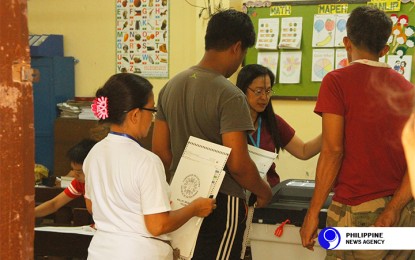
MANILA -- As this year’s May 13 mid-term elections come closer, many of the country’s millennial voters may be interested to know that the Filipino people used to go to the polls every two years in November under the 1935 Constitution, instead of today's second Monday of May.
The elections under the 1935 Charter were classified as national (for the president and vice president), local, and senatorial (for eight of the 24 members of the Senate).
Section 3, Article VI (Legislative Department) of the 1935 Constitution stated, “The first senators elected under this Constitution shall, in the manner provided by law, be divided equally into three groups, the senators of the first group to serve for a term of six years, those of the second group, for four years, and those of the third group, for two years.”
The biennial elections used to take place on the second Tuesday of November, from 1946 until November 1971, when the last local and senatorial elections were held under the 1935 Constitution due to the abolition of Congress with the declaration of a nationwide state of martial law on Sept. 21, 1972 by then president Ferdinand E. Marcos.
It is also worth mentioning that under Section 1 of Article V (Suffrage) of the same Charter, the right of suffrage was exercised only by Filipinos who were at least 21 years of age. This was different from the present voting age of 18 years as provided for in the 1973 and 1986 Constitutions.
The terms of office of the elected officials began on December 30 following the election. Again, this differed from June 30, the current start of the term of office of elected officials under the 1987 Constitution.
According to the Records and Statistics Division of the Commission on Elections (Comelec), the last election under the 1935 Constitution was held on Nov. 8, 1971 for eight of the 24 senators and local officials, such as members of the House of Representatives, governors, vice governors and provincial board members, city and municipal mayors, vice mayors and councilors.
The then opposition Liberal Party took five seats in the Senate while three seats went to the administration party, the Nacionalista Party. That election took place barely two-and-a-half months after the Plaza Miranda bombing on Aug. 21, 1971, which wounded most of the LP's senatorial candidates.
Those who emerged winners were senators Jovito Salonga (LP), Genaro Magsaysay (LP), John Henry Osmeña (LP), Eddie Ilarde (LP), Eva Estrada Kalaw (NP), Ramon Mitra Jr. (LP), Ernesto Maceda (NP), and Alejandro Almendras (NP). However, their terms were cut short due to the declaration of martial law.
Following is a list of the 16 political exercises held under the 1935 Constitution (1946-1971), according to the Comelec’s Records and Statistics Division:
April 23, 1946, national election; March 11, 1947, plebiscite; Nov. 11, 1947, local and senatorial elections; Nov. 8, 1949, national election; Nov. 13, 1951, local and senatorial elections; Nov. 10, 1953, national election; Nov. 8, 1955, local and senatorial elections; Nov. 12, 1957, national election; Nov. 10, 1959, local and senatorial elections; Nov. 14, 1961, national election; Nov. 12, 1963, local and senatorial elections; Nov. 9, 1965, national election; Nov. 14, 1967, local and senatorial elections; Nov. 11, 1969, national election; Nov. 10, 1970, election of 1971 Constitutional Convention delegates; and Nov. 8, 1971, local and senatorial elections.
The special national election of April 23, 1946 was held in accordance with Commonwealth Act No. 725. It was won by Manuel A. Roxas as president and Elpidio Quirino as vice president.
According to Wikipedia website, the March 11, 1947 plebiscite ratified the parity amendment to Article XIII of the 1935 Constitution, which reserved the exploitation of the country’s natural resources only for Filipinos. That amendment granted United States citizens and corporations equal rights with the Filipinos in the exploitation of natural resources.
The Nov. 14, 1967 plebiscite was timed with the local and senatorial elections that year for the voters to decide on certain Charter amendments, including an increase in the number of congressional seats from 120 to 180 and allowing senators and congressmen to serve as delegates to the 1971 Constitutional Convention (ConCon) without forfeiting their seats. Both proposals were rejected in the plebiscite.
In the Nov. 10, 1970 election, the people voted for 320 delegates to the 1971 ConCon that was proposed to frame a new Constitution.
The delegates convened on June 1, 1971, but the deliberations of this body were also overtaken by the imposition of martial law. (PNA)
